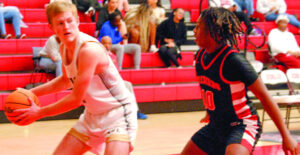Astronauts gear up for second walk
By Staff
FLOATING n Space shuttle Atlantis commander Kenneth Cockrell, top left, works above astronauts Marsha Ivins, bottom left, Thomas Jones, center, and pilot Mark Polansky Sunday in the Destiny science laboratory module of the international space station. AP photo/NASA TV.
Feb. 12, 2001
SPACE CENTER, Houston (AP) A day after opening the doors to Destiny, astronauts aboard space shuttle Atlantis had two main tasks: move a docking port and continue outfitting the new lab during a spacewalk.
On Monday, astronaut Marsha Ivins was set to use the shuttle's robotic arm to place a docking port at the end of Destiny, the international space station's new science laboratory.
The port, which will serve as the primary shuttle docking location for the next several missions, had been moved to a temporary location during the mission's first spacewalk Saturday so the lab could be attached to station Alpha.
Spacewalkers Thomas Jones and Robert Curbeam Jr. were expected to help Ivins with her task and also attach various equipment and fixtures to the exterior of the $1.4 billion lab, including the future connection point for the space station's robotic arm due to be brought up in April.
If the docking port can't be attached to Destiny, it would halt future space station construction. Another mission would have to be scheduled or the next one in early March would have to be revamped in order to get the docking port connected, flight director Bob Castle said.
A shuttle could dock in the same port Atlantis is using but the lab would be right above the payload bay.
The complex mission has so far proceeded without any major problems.
I am very pleasantly surprised that it has gone as well as it has,'' Castle said.
Monday's spacewalk was the second of three scheduled for the mission to mount and outfit Destiny which is 28 feet long and 14 feet in diameter.
On Sunday, the crews of Atlantis and Alpha installed fire extinguishers and emergency masks and lights in the laboratory. They also hooked up the air-circulation system, cameras and computers. There was no research equipment to set up; the first experiment doesn't arrive until next month.
Destiny's computers and systems will allow NASA to take control of the space station in a month or two. Up until now, the two Russian pieces of Alpha provided the life support and commanding capability.
The lab also gives station commander Bill Shepherd and his two Russian crewmates more room to work in and live. They have been aboard Alpha since Nov. 2.
The addition of Destiny makes Alpha the largest orbiting outpost ever in terms of habitable volume.







